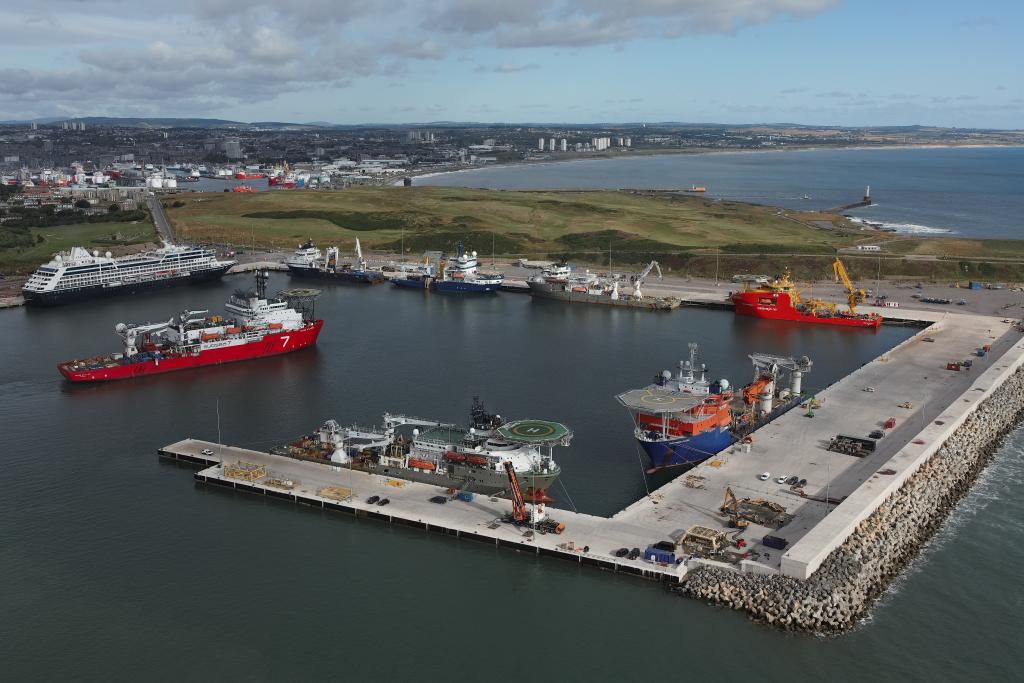
Port of Aberdeen – At the heart of Scotland’s growth in energy, trade, and tourism

As 2023 draws to a close, the official opening of Port of Aberdeen’s £420 million South Harbour expansion in September marked a historic milestone.
With over 7,000 vessel calls in 2023, the extended port can now welcome vessels up to 300 metres long and offers 7,400 metres of quays, including 2,800 metres of deepwater berths to a maximum depth of -15 metres, with large flexible laydown and project areas adjacent to the quayside.
With its infrastructure transformed, Port of Aberdeen will be a catalyst for regional and national growth in energy, trade and tourism.
Energy
Aberdeen South Harbour enhances the port’s offering for its existing customers in oil & gas and decommissioning, as well as supporting the next generation of low carbon energies, such as offshore wind and hydrogen.
Port of Aberdeen is a world-class marine logistics hub for offshore wind, from survey and construction, installation and commissioning, operations and maintenance, through to decommissioning.
The port has supported wind developments for many years, and its North Harbour is the operations and maintenance base for Aberdeen Offshore Wind Farm and Kincardine Offshore Floating Wind Farm. The extended port has furthered its capabilities, providing extensive infrastructure ideally suited for the efficient final assembly and integration of floating offshore wind projects.
Within 200km of 75% of current and future Scottish wind farms, more than 700 renewables vessels utilised Port of Aberdeen in 2023, largely driven by support for offshore wind projects, including Seagreen, Moray East/West and NnG. The substantial increase in quayside length and deepwater berths has attracted vessels such as Fred. Olsen Windcarrier’s Blue Tern which would have previously sailed by the city.
In addition to embracing the larger renewables vessels, the port is exploring opportunities with stakeholders in hydrogen. One example is a study funded by the Scottish Government to explore the feasibility of subsea hydrogen storage. Additionally, the port is in discussions with hydrogen exporters to evaluate infrastructure requirements.

Landside Decommissioning at Aberdeen South Harbour
Trade
Port of Aberdeen stands not just as a key player in the energy transition but also as a pivotal connector for trade, linking North East Scotland to more than 40 countries, stretching from Europe, Africa, Asia and more.
Specialising in safely transporting diverse cargo like grain, project cargo, bulk products (liquid and dry), forest products, manufactured goods, food and beverages, the expanded port has broadened both the variety and volume of cargo it can handle.
The specially designed infrastructure positions the port as an integrated logistics and services hub, offering ample laydown space, heavy-lift capability, large-scale cargo handling equipment, and warehousing. The new facilities also expand the potential to take freight off from roads, lessening traffic congestion and emissions.
Roddy James, Chief Commercial Officer, Port of Aberdeen, said: “The extended port enhances our offering for streamlined cargo handling to safely managing the flow of goods. As a strategic multimodal hub, the port is seeing cargo from more countries, playing a pivotal role in connecting the broader global network with the North East of Scotland.”
Port of Aberdeen welcomed more than 275 cargo vessels to the port in 2023, carrying over 3 million tonnes of cargo, including dry and wet bulk products, fuel and manufactured products.

The 220m long Renaissance cruise ship had two calls to South Harbour in 2023
Tourism
As well as expanding its capabilities for the trade sector, Aberdeen South Harbour has significantly increased the port’s capacity for cruise calls and can accommodate around 90% of the global cruise fleet.
After a record-breaking cruise season in 2023, which saw 43 cruise vessels visit Aberdeen, the port expects over 60 cruise calls from April to October 2024. This will bring tens of thousands of UK and European guests to the region and bookings extend to 2026, ensuring a substantial local economic boost.
Aberdeen South Harbour is proving to be essential for the North East and the wider UK, positioned at the heart of energy, trade, and tourism.
The expansion, which fully aligns with its core mission of creating prosperity for generations, will also further the port’s ambition of becoming Scotland's premier net zero port by 2040.




